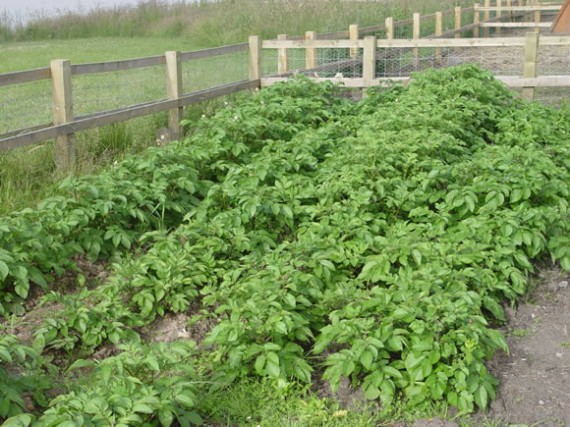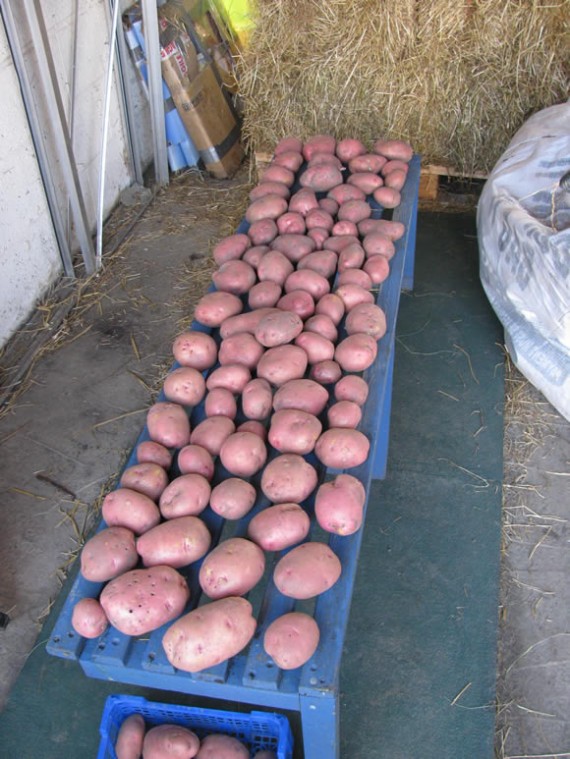Plant care and harvest
Planting guide
| First earlies | Second earlies | Early maincrop | Maincrop | |
|---|---|---|---|---|
| Planting distance in row | 30cm | 40cm | 45cm | 45cm |
| Distance between rows | 60cm | 75cm | 75cm | 75cm |
| Planting depth | 8cm | 8cm | 13cm | 13cm |
| Plant date | End February to late May | March to late May | March to late May | March to mid-May |
| Weeks from planting to harvest | 10 | 13 | 15 | 20 |
Plant care
Protect early sprouted foliage from frost by covering with earth or compost and continue to earth up until the ridges are about 20cm high.
Weed between the rows as required. As the haulms grow they will shade out most weeds.
 A healthy potato bed
A healthy potato bed
In dry weather, water well especially at flowering as this is when the tubers start to form. Occasional (every 10 days or so) heavy watering is preferable to frequent light watering as the latter encourages shallow rooting
Yields
Obviously, yield is dependent on many factors, but a 3m row of earlies will yield up to 5.5kg, while a 3m row of maincrop will yield up to 9kg of potatoes.
Harvesting potatoes
As you can see from the table above, you can have your own spuds from the middle of May until your stored maincrop potatoes run out. Start checking early potatoes once the flowers open; new potatoes are usually harvested when they are the size of hens’ eggs.
We can never resist cropping one or two new potato plants a wee bit early. The spuds are never very large, but they taste fabulous and there's something uplifting about the first potato harvest of a new season.
You can eat maincrop potatoes freshly dug, but if you plan to store them for future use, wait until the haulms (tops) have withered. Cut the withered haulms away and wait about ten days, then, on a dry day, carefully fork up the potatoes carefully and leave them on top of the soil for a couple of hours (not more than two or they will start turn green and will be poisonous to eat) to dry and set the skins.
 If the weather's poor you can dry potatoes indoors, but ensure good air circulation
If the weather's poor you can dry potatoes indoors, but ensure good air circulation
Check for any damaged potatoes and either discard or use immediately, then store the good potatoes in hessian or paper sacks or boxes in a cool, dark, frost-free place.
Don’t store in polythene, as this will cause the tubers to sweat and rot.
Try to remove all tubers from the soil – even very small ones – to avoid disease problems in future, and to avoid unexpected crops in future years!
- Previous « Soil for potatoes
- Next Potato problems »

About Rosemary Champion
Rosemary lives on a 12 acre smallholding in Angus, in the east of Scotland, where she keeps Ryeland Sheep, Shetland cattle and assorted poultry. She was destined to be a smallholder from an early age.
Further Reading
 Vegetable Growing Month-by-month John Harrison |  Kitchen Garden Estate: Self-sufficiency Inspired by Country Estates of the Past Helene Gammack |  Fruit and Vegetables for Scotland: A Practical Guide and History Kenneth Cox and Caroline Beaton |  The Vegetable and Herb Expert Dr D G Hessayon |  Comfrey: Past, Present and Future Lawrence D. Hills |

















